lecture 1
...
viruses are living/not living
NOT living
not cells (no nucleus, organelles, cytoplasm)
viruses called
subcellular infectious agents
and
obligate intracellular parasites
- must be in cell to function
outside of cells, the virus is just a
complex nucleoprotein particle
doesnt do anything outside the cell
viruses are not the only obligatory intracellular parasite
other unicellular organisms, some bacteial species, some protozoa can multiply only inside other host cells
nucleic acid of viruses
can have EITHER
- DNA
- OR
- RNA
NEVER BOTH!!!
viral reproduction mode
synth. subunits (proteins), then assemble the virus
(very distinct from other things, like bacteria can do fission, etc.)
can viruses grow outside of host cell?
NO
are viruses susceptible to antibiotics?
NO
viruses cannot make ___ independent of host cell
energy or proteins
properties of virus
filterable agents
obligate intracellular parasites
viral components assembled
genome can be DNA OR RNA (never both)
morphology: naked capsid OR envelope
consequences of viral properties
- viruses not living
- must be infectious to endure in nature
- must be able to utilize host cell processes to make their components (mRNA, protein, copies of their genomes, etc.)
- must already have/encode for processes that the cell doesnt provide
- viral components must self assemble
ancient times
- realized that infectious diseases were transmitted by air, water, food, or close contact to sick ppl caused by mysterious elements in fluids called virus
- had ppl w rabies and didnt know what it was
- had ppl w polio and didnt know what it was
effective vaccines against smallpox and rabies developed in 1798 and 1995
no clear understanding of the nature of these disease agents, which are know now as viruses
- didnt understand, just know some things were working
- showed that agent that caused tobacco mosaic disease could passn through fine earth or porcelain filters which retain bacteria
- VIRUSES WERE FIRST DISTINGUISHED FROM OTHER MICROORGANISMS BY FILTRATION
experiments established that certain infectious agents are much smaller than bacteria - called filterable viruses
using filtration as diagnostic tool -> many viruses were discovered in first half of XX century
- 1st tumor virus (RVS, rous sarcoma virus) isolated from sarcomas of chicken in 1911
- years later -> RSV recognized as representative of retrovirus family
- RSV virus which existance of oncogenes was discovered
- wendell stanley
found that purified tobacco mosaic virus could form
crystals
- shocked scientific world bc placed viruses at edge btw living organisms and chemical compounds
- posed question: are viruses living or inanimate???
- CRYSTALLIZATION OF TOBACCO MOSAIC VIRUS CHALLENGED CONVENTIONAL NOTIONS ABOUT GENES AND NATURE OF LIVING ORGANISMS
- Show many properties of life ONLY when inside cell (given means to support replication) because they have ability to mutate, evolve, etc
VIRUSES ARE INANIMATE WHEN THEIR GENOMES PACKAGED IN VIRIONS
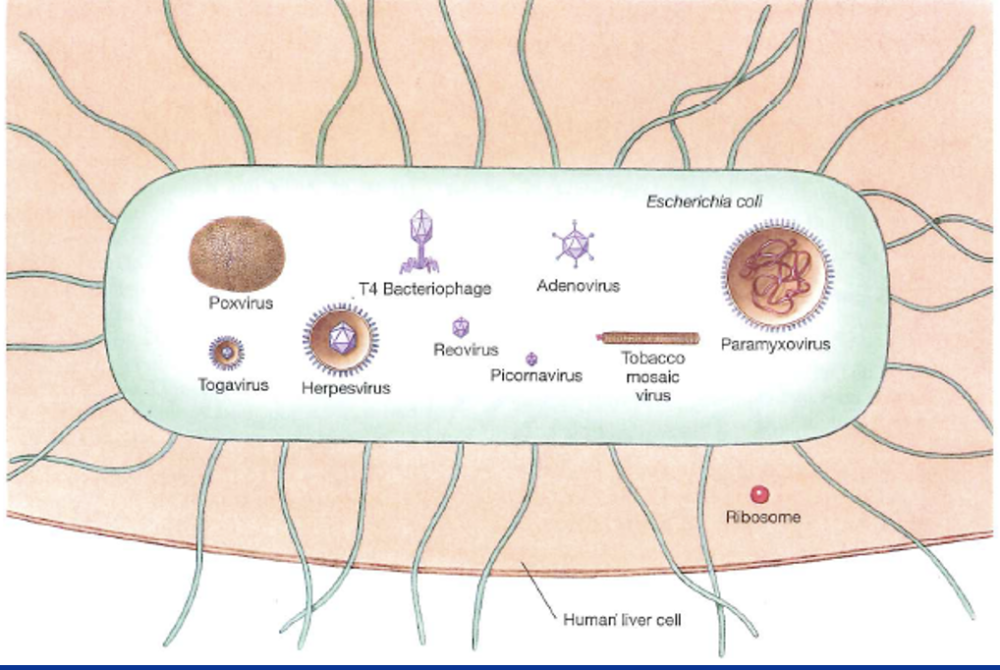
- they do share many properties of life:
- ability to mutate, evolve, reproduce themselves when enter cells that support their replication
- stanley and others showed that viruses contain both protein and nucleic acids
- at the time, it was still not known that genes were made up of nucleic acids
- dev of electron microscope allowed scientists to see viruses for first time (1930s)
possible origins of viruses
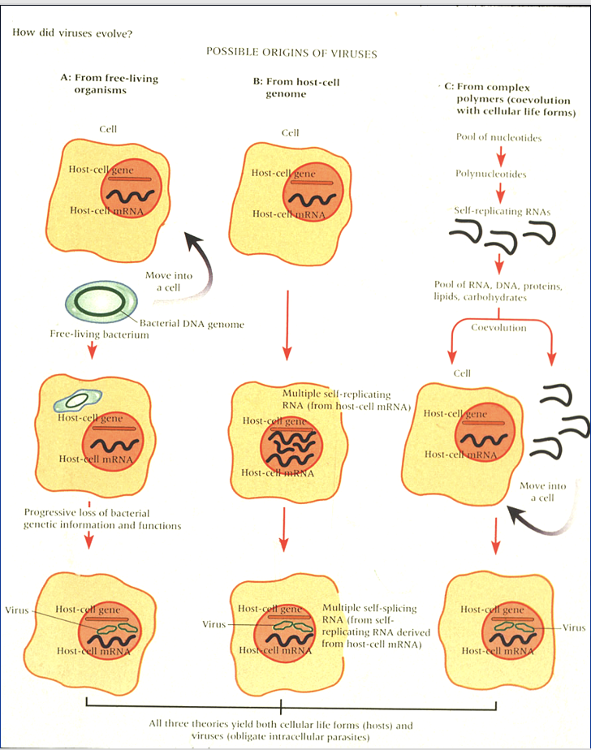
see pic
virion components
- nucleic acid - DNA or RNA
- capsid
- nucleocapsid - capsid + nucleic acid core
- envelope
- capsomer
nucleocapsid
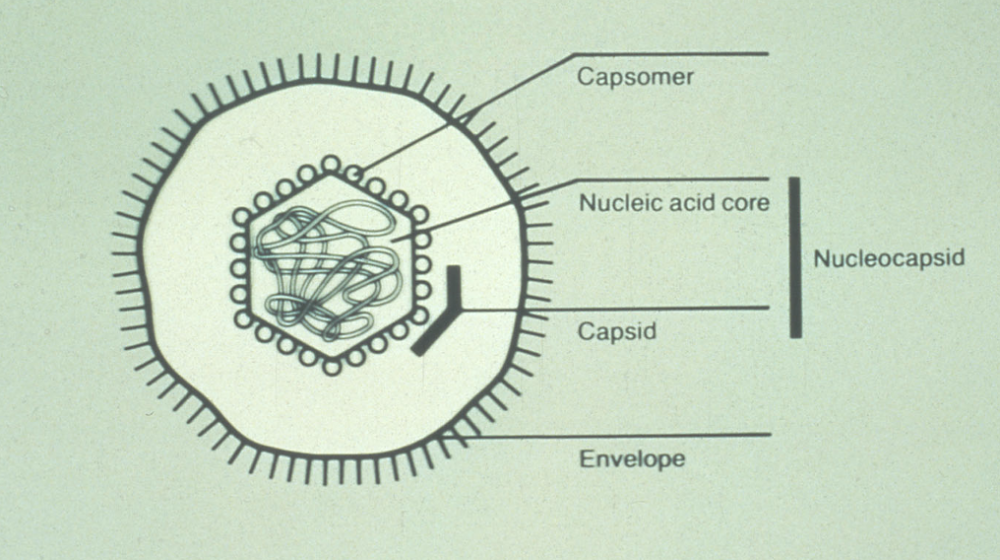
capsid + nucleic acid core
naked capsid virus
nucleocapsid
- DNA/RNA
- proteins
enveloped virus
- nucleocapsid
- glycoproteins and membrane
nucleic acid process
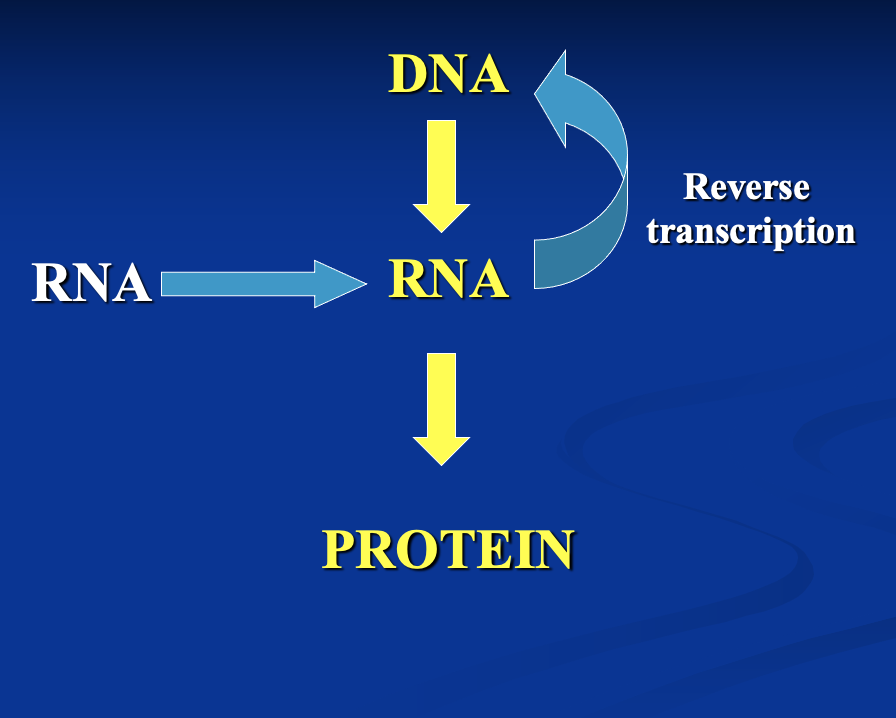
- DNA -> RNA -> PROTEIN
- RNA -> DNA in viruses
that use reverse transriptase
- DNA from RNA to make more RNA
viral nucleic acid characteristics
- single vs double stranded
- segmented vs nonsegmented
- linear vs circular
- positive vs negative stranded vs ambisense
enzymes in viral replication
DNA dependent
- DNA polymerase
- RNA polymerase
RNA dependent
- RNA polymerase
- DNA polymerase
viral encoded vs carried in the vial particle
- if virus codes for it, or if it carries it
defective viruses
lack complete genome
= cannot replicate completely/cannot form protein coat
abortive infections
failed infections of a cell
nonpermissive cells wont allow:
replication of a particular type / strain of virus
permissive cells provide:
biosynthetic machinery to support the complete replicative cycle of the virus
viral capsid symmetry
2 types symmetry present in capsids
- cubic symmetry (icosahedron)
- helical symmetry
- neither - ex: poxvirus
cubic symmetry
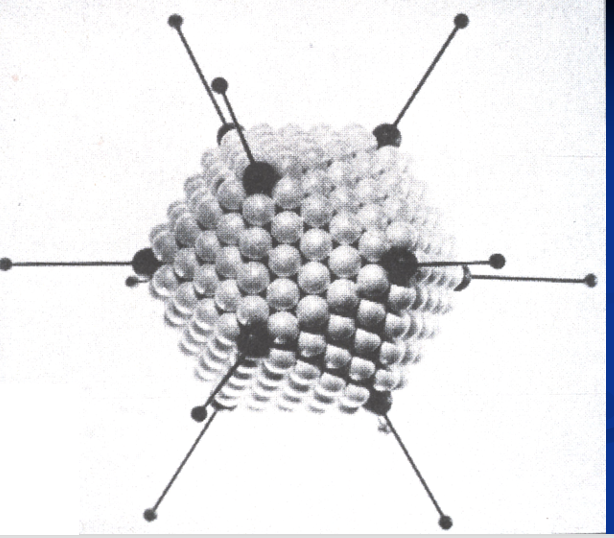
icosahedron
helical symmetry
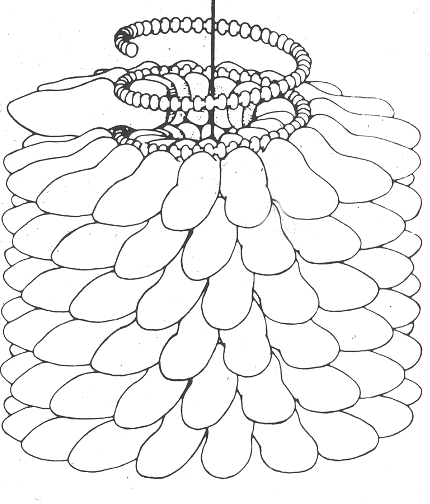
- circles inside = nucleic acid
- circles outside = capsomeres that cover and give helical configuration
- for viruses that infect HUMANS
- all these have OUTER ENVELOPE
capsomere is made of what proteins
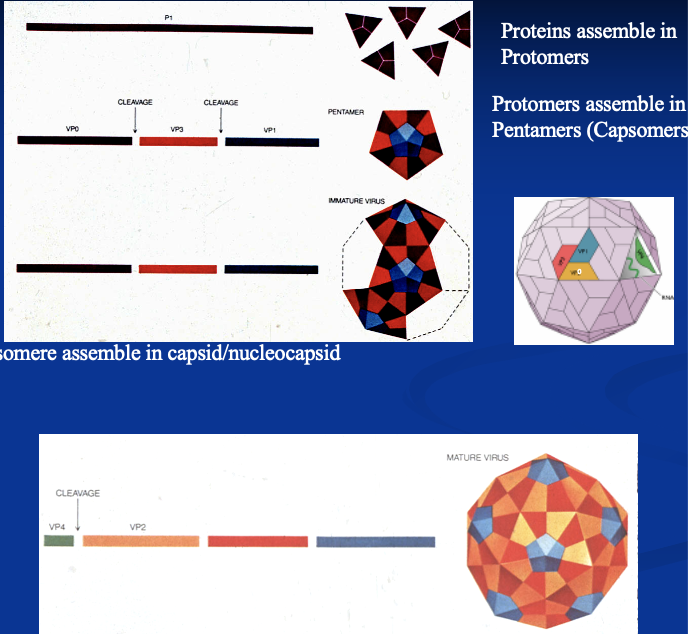
protomers (= cleaved long proteins made by virus)
they are assembled into pentamers (capsomers)
= how get mature virus form
again, diff btw naked and enveloped virus
naked capsid virus can become enveloped virus (if gains the components)
naked virus = nucleocapsid
enveloped virus = nucleocapsid, AND:
- structural protein = matrix protein
- only thing inside
- lipid bilayer (outer membrane from host cell)
- glycoprotein - in order to have receptor proteins
virus structure - naked capsid
- only protein structure
naked capsid virus properties
stable to:
- temp
- acid
- proteases
- detergents
- drying
release from cell by lysis
consequenes of naked capsid virus properties
- spread easily (on fomites, hand-hand, droplets, etc.)
- dry out + retain infectivity
- survives gut
- resistant to detergents + bad sewage treatment
- can elicit protective antibody response
naked capsid viruses release from the cell by
lysis
viral structure: enveloped
- proteins
- membrane
- lipids
- glycoproteins
enveloped virus properties
disturbed by:
- acid
- detergent
- drying
- heat
modifies cell membrane during replication
enveloped virus is released from cell by
budding and cell lysis
- bc use membrane of host cell
enveloped virus properties consequences
- must stay wet
- cannot survive GI tract
- spreads in large droplets, secretions, organ/blood transplants
- doesnt need to kill cell (budding)
- initiate cell mediate immune response
- pathogenesis often bc of hypersensitivity and inflammation due to cell mediated immunity
subviral pathogens
- viroids - are only RNA
- prions - are only protein
smaller than viruses
viroids
smallest known pathogens
naked, circular, ssRNA - dont encode protein
only infect plants
comparison of viruses, viroids, prions
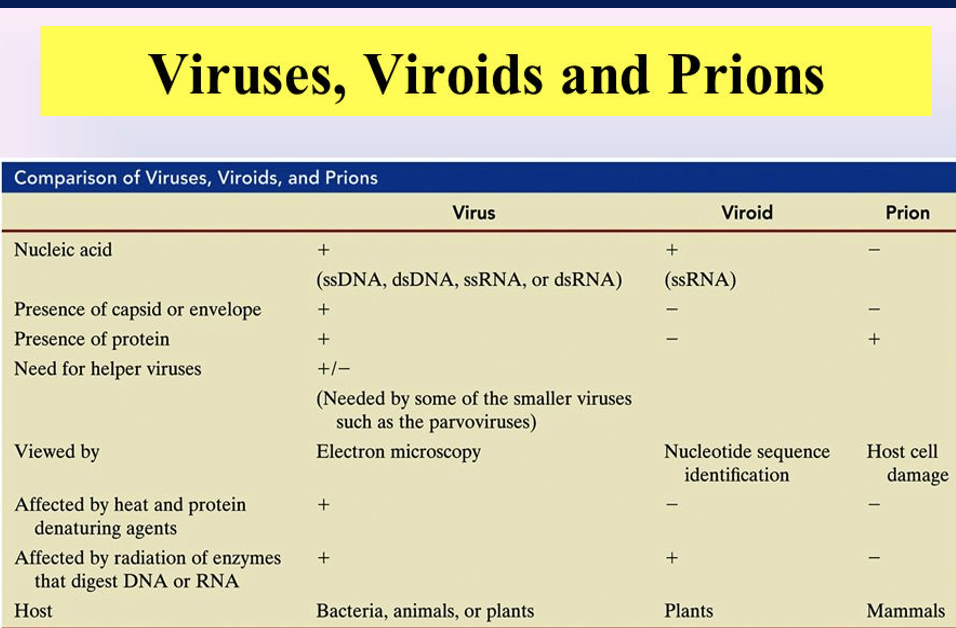
baltimore classification of viruses
...
LECTURE 2
animal cell culture
outline
- characteristics of animal cell culture
- growth factors
- cell cycle
- cell transformation and elements of cancer
1. characteristics of animal cell culture
...
animal cells cannot live outside of
their in vivo tissues/environments
a cell culture is the maintenance of cells
in vitro (on glass)
cell culture involves
taking cells from their natural setting, characterizing their growth and functional properties, and keeping them in culture so that they are readily available for experimentation
- start w/ animal cell culture
- culturing is taking cells from vivo environment to conditions in another place they can grow (in vitro)
cells can be grown in culture
cells grown in culture provide more homogenous population of cells from which to extract material, and they are also much more convenient to work with in the lab (in sterile plasticware)
ex vivo cell culture
cells directly from animals/humans
(extracting primary cells from them)
in vitro
In vitro literally translates from Latin as “in glass.” These methods involve experimenting with cells outside a living organism. The original reference to glass is quite literal since in vitro experiments were historically conducted in Petri dishes or test tubes, made of glass.
In vitro cultured cells are purified and isolated from their natural biological environment.
(google)
ex vivo
Ex vivo literally translates from Latin as “out of the living.” In these experiments, living tissues are directly taken from a living organism and immediately studied in a laboratory setting with minimal alterations to the organism’s natural conditions. An example of this is the use of human skin explants derived from surgical procedures.
in vivo
these investigations refer to experiments in live animals (NOT in cell cultures)
when conducted in humans = clinical (translational) research
studying animal as a whole
isolating cells and growing them in culture
isolated from INTACT TISSUE where they live in body
- disrupt ECM and cell-cell junctions that hold cells
together
- treat w/ proteolytic enzymes (trypsin, collagenase) = digest + destroy proteins in ECM
- treat w/ agents as EDTA that bind Calcium ions that cell-cell adhesion depends on
- tissue can be separated into single cells by agitation
cells can be separated from a mixed cell suspension
- most general cell separation techniques: use antibodies coupled to flourescent dyes/magnetic beads = label specific cells (cell sorting)
- antibody - molecule produced by B lymphocyte, specifically recognizes certain structures of other molecules (antigens)
primary cell cultures
- cell culture established from organs/tissue
- eventually
die
- hayflick limit - limit of division of about 50-70 times
- experience senescence and death
hayflick limit
- replication capacity of a cell before experiencing senescence and death
- 50-70 divisions
- only occurs in differentiated cells (stem cells can continue to divide)
- this occurs in our bodies as well
senescence due to
progressive shortening of telomeres (with each cell division)
telomeres
repetitive DNA caps at end of each chromosome
telomerase
elongates telomeres, which are shortened after each cell division
cells stop making telomerase, which is why their telomeres shorten with each division -> leading to eventual senescence and death of the cell
cancer cells express
telomerase continuously
since they express it, their telomeres do not shorten, and thus, cancer cells are immortal
fate of primary cells
senescence
- cells stop proliferation at hayflick limit after certain number divisions
- if they remain normal cells, senescence will occur
- cell strain
- euploid
- before senescence is reached, cells may be changed by viruses, carcinogens, etc or spontaneous transformation -> cell line
cell strain
euploid (normal # chromosomes) population of cells
immortalization
- cell line
- aneuploid (abnormal # chromosomes or changed chromosomes)
- occurs if primary cells (normal cells) undergo transformation into abnormal ones
- can be cultured indefinitely due to telomerase continuation
cell line
aneuploid (abnormal # or changed chromosomes)
can culture indefinitely bc of telomerase activity continuation, do not die
normal cells can turn into abnormal cells (cell line) by carcinogens, transforming viruses, spontaneous transformation, etc.
transformed cell line
- line of cells derived from the cell lines
- in vitro characteristics of tumor cells (foci)
- can turn into these bc of carcinogens, etc. (stated before)
tumor cell lines
cell line derived from primary tumor cells (ex vivo tumor cells, from an organism)
transformed cell lines and tumor cell lines grow...
without attaching to a surface and proliferates to much higher density in a culture dish
normal cells treated w/ carcinogenic chem compounds or with transforming viruses can result in...
transformed cell line
transformed cells injected in mice can cause
tumors in mice
if smth injected in mice and cause tumors, the chemical is considered
carcinogenic
short and long term test for genotoxicity and carcinogenicity (transformation test)
cell lines differ in important ways from normal progenitors in tissues from which they were derived
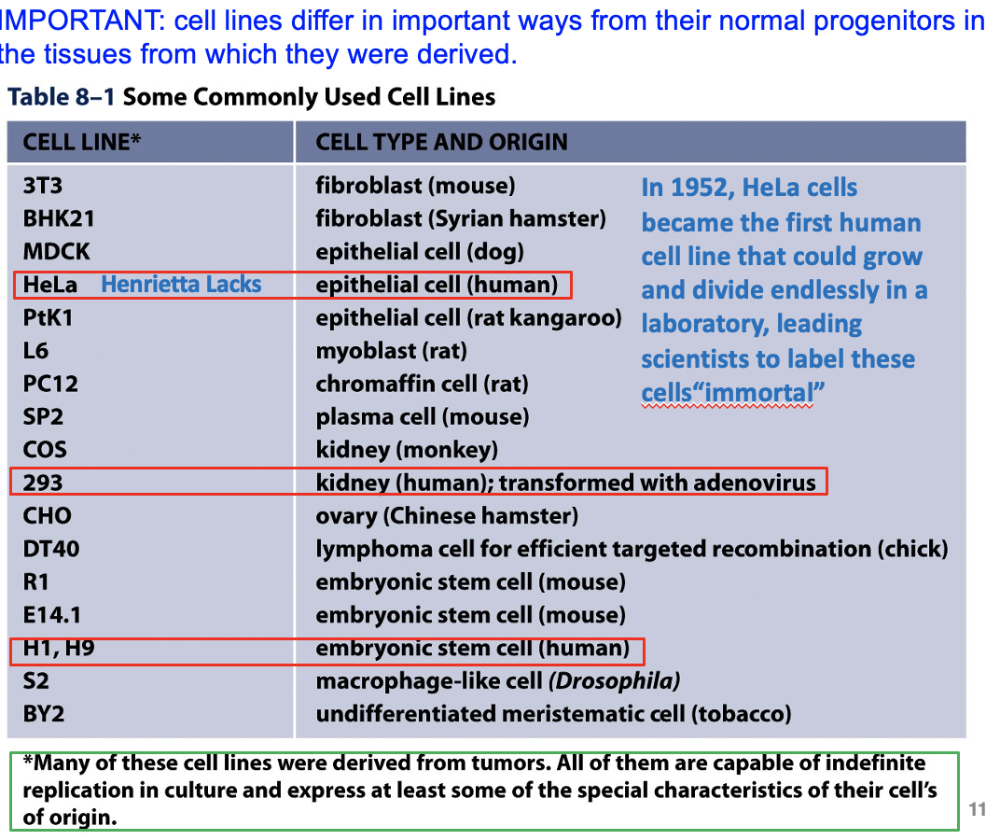
see pic
cell culture medium
- must resemble blood plasma, so has things to make it as similar
as possible
- amino acids, vitamins, glucose, buffers, serum, antibiotics, etc. additives
types of cells in cell culture
all animal cells in culture derived from animal tissue
- adherent vs suspension
cell types
- primary cells - eventually stop replicating
-
continuous cell lines
- transformed/tumor/spont. altered cells
- stem cells
stem cell line
stem cells (self renewing) cultured in vitro and can be propagated indefinitely
derived from either animal or human tissues and come from 1 of 3 sources
- embryonic stem cells
- adult stem cells
- induced stem cells
properties of primary cells
- euploid
- high serum conc.
- finite lifespan/hayflick limit
- display properties of differentiated cells
- respond to modulators of cell growth (growth factor, inhibitor, etc)
- do NOT produce tumors
- adherent cells - need contact with solid surface for division (anchorage dependent growth)
- subject to contact inhibition - stop growing when touch neighbor cell, grow again when have space
properties of continuous cells (cell lines)
- aneuploid
- may have anchorage
independent growth
- dont need to be anchored to duplicate
- immortal - divide forever bc telomerase
- do not respond to neighboring cells - no contact inhibition
- dont display properties of differentiated cells
- do not respond to modulators of cell growth
effect of virus infected cells
exert modifications on cells
-
cytopathic (cytolytic) viruses
- kill their host cells (lysis)
- either completely eliminated by immune system or kill infected organism (lysis)
-
noncytopathic viruses (LCMV)
- propagate without killing their host cells
- leave cell via other mechanisms
-
persistent virus
- ex: herpes virus, chickenpox, shingles
- lytic/latent life cycle
- CANNOT be cured of this virus
- virus hides until immunosuppression, then comes out
- cytopathic or cytopathogenic effects (changes in host cell
caused by viral invasion)
- change morphology
- apoptosis
- necrosis
- cell fusion (syncytia)
- hemagglutination
- change in growth or lifespan
- oncogenic transformation
cytopathic (cytolytic) viruses
- kill their host cells (lysis)
- either completely eliminated by immune system or kill infected organism (lysis)
noncytopathic viruses (LCMV)
- propagate without killing their host cells
- leave cell via other mechanisms
persistent virus
- ex: herpes virus, chickenpox, shingles
- lytic/latent life cycle
- CANNOT be cured of this virus
- virus hides until immunosuppression, then comes out
apoptosis
active, programmed process of autonomous cellular dismantling occurring in a cell, that avoids eliciting inflammation
necrosis
passive, accidental cell death of a group of cells resulting from environmental pertubations with uncontrolled release of inflammatory cellular contents
some viruses use necrosis, some use apoptosis
...
cell fusion (syncytium)
viral proteins that mediates fusion of an infected cell with neighboring cell
- lead to formation of multinucleate cells - syncytia
virus w/ this puts molecules on surface that cause fusion of cell w/ neighboring cell
ex: flu, COVID, syncytium resp. virus
hemagglutination
rxn that causes clumping of RBC in presence of some enveloped virus
glycoprotein on viral surface (hemagglutinin) interacts w/ RBCs leading to clumping of RBCs
virus attach to RBC and agglutinate
ex: flu
RSV causes
tumors
is a transforming virus
primary cells / cell lines / immortality/ telomers / telomerase: summary
which are cells that can replicate?
-
in vivo - in embryo and adults
-
embryo - embryonal cells, stem cells
- pluripotent - undifferentiated, can become any cell type
-
adult - adult stem cells
- multipotent - restricted to become any type of cell in the tissue/organ they reside (bone marrow, fat, brain, blood vessels, skin, teeth, heart, liver)
- adult stem cells replace cells lost in tissue as needed (ex: skin growth every day)
- benign + malignant (cancer) tumor cells
-
embryo - embryonal cells, stem cells
- telomerase expressed/activate in tightly controlled + regulated fashion, except in malignant cells where it is cont. expressed/activated and they are then immortal
Embryo stem cells - Pluripotent – undifferentiated, can become any type of cell
Adult stem cells – multipotent
- replace cells lost in tissue/organ they reside as needed
Benign and malignant tumor cells
- tumor cells can be benign – have capacity to replicate, but do not metastasize and invade
- telomerase expressed regulated/controlled
which are cells that can replicate?
now in vitro:
- primary cells - limited capacity: hayflick limit, telomers shorten progressively, senescence, death
- telomerase continuously expressed/activated enabling cell
immortality in the following:
- spontaneous generated cell lines
- transformed cell lines
- tumor (cancer) cell lines
telomerase - (an enzyme) is a ribonucleoprotein complex
- catalytic core: telomerase reverse transcriptase (TERT)
- noncoding human telomerase RNA (hTR) which serves as template for the addition of telomeric repeats to chromosome ends
cellular senescence is a permanent proliferation arrest that occurs in response to:
endogenous and exogenous stresses, including telomere dysfunction
also to oncogene activation, tumor suppressor genes inactivation, oxidative stress, mitochondrial dysfunction, and persistent DNA damage
senescence occurs at the ___ levels and is related to the ___ process but not necessarily to death
- cellular, tissue, organ, and body levels
- related to the aging process
senescent cells start producing what molecules?
inflammatory
II. GROWTH FACTORS
part 2 of lecture
- secreted proteins which exert their effects at very low concentrations (1-^-9 to 10^-11 M)
- regulate protein synthesis and cell growth
- act on cells that express specific receptors
- can stimulate or inhibit proliferation or differentiation
- over 60 known growth factors
- broad specificity
- narrow specificity
growth factors = proteins
growth factors and their actions
the main growth factors
dont need to memorize
produced by diff cell types
macrophages make most types of growth factors
signaling pathways
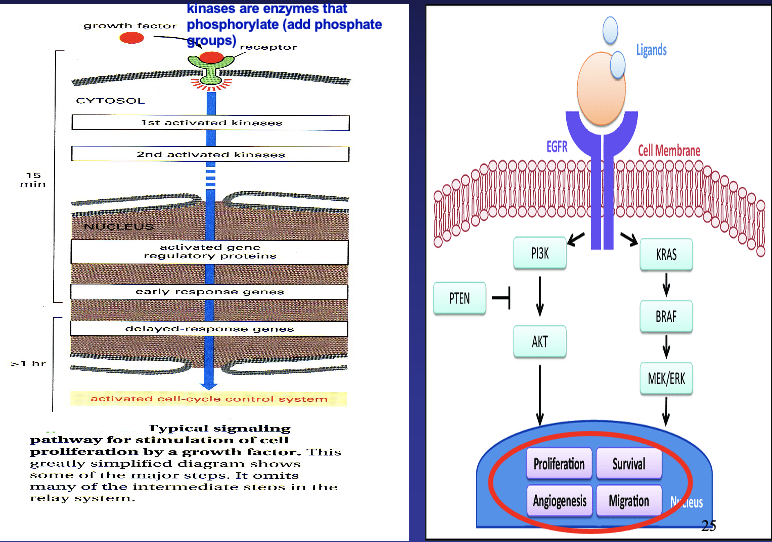
Growth factors act on specific receptors
- end: give info in nucleus for cell to express certain thing
Interact w/ receptor -> phosphorylate -> kinases activated/phosphorylated
- Kinases go to nucleus -> activate gene/regulatory proteins
- Genes have to do w/ expression, regulation etc.
4 types chem signaling
- autocrine
- across gap junctions
- paracrine
- endocrine
autocrine
- cell targets itself
- signaling acts on the signaling cell
- 1 cell produce growth factor that goes back to interact w/ growth factor on same cell that produced it
- Bc only way to induce this function, must go out and activate the cell signaling pathway
signaling across gap junctions
- cell targets a cell connected by gap junctions
- signaling molecules moving directly between adjacent cells
- internal receptors found in cell cytoplasm
- bind ligand molecules that cross the plasma membrane
paracrine
- a cell targets a nearby cell
- signaling act on nearby cells
- Growth factor act on receptor in neighbor cell
endocrine
- a cell targets a distant cell through the bloodstream
- signaling uses the circulatory system transport ligands
III. the cell cycle
part 3
- the cell cycle, or cell division cycle, is the series of events that take place in a cell leading to its division and duplication (replication)
- cell cycle can be divided in 2 periods
- interphase
- cell growth
- mitosis
- cell division into 2 daughter cells
- cell cycle consists of four distinct phases
- interphase
- G1 phase
- S phase
- G2 phase
- 4. M (mitosis)
cell cycle can be divided in 2 periods
- interphase
- cell growth
- mitosis
- cell division into 2 daughter cells
cell cycle consists of four distinct phases
- interphase
- G1 phase
- S phase
- G2 phase
- 4. M (mitosis)
cell cycle checkpoint
- checkpoints used by cell to monitor + regulate progress of the cell cycle
- checkpoints
- G1 - ensure ready for DNA synthesis
- G2 checkpoint - ensure ready to enter M phase and divide
- if not, mitosis avoided
- metaphase checkpoint - ensure cell ready to complete cell division
- chromosomes aligned?
cells can enter nongrowing G0 state
due to serum deprivation of the proliferating cell in culture -> arrest and into G0 state
protein synth. rate decreases to 20%
cannot pass G1 checkpoint/go into G1
cell cycle synchronization
- process by which cells in a culture at diff stages of cell cycle are brought to the same phase
- vital for cell study -> population-wide data
2 types of cell synchronization
- physical fractionalization
- chemical blockade
can do synchronization by
- serum starvation
-
chemically
- nocodazole - arrest at metaphase
- hydroxyurea - block in S phase
- mimosine - late G1 arrest
IV. cell transformation + elements of cancer
Generation of transformed cells (mechanisms of cell transformation)
- culturing of primary cells for long periods (rodent cells)
- mutagenesis (genotoxic chemical compounds or other means)
- mutagens can transform the cells
- tumor viruses (HTLV-1)
- viruses can transform the cells
- transfection with oncogenes
- oncogenes can be responsible for inducing cancer
- can be isolated from tumors (= tumor cells)
malignant cell transformation refers to "initiation" first step on carcinogenesis model
- as occurring in any cell w/ initiating first mutation in any gene relevant to cancer
- malignant cell transformation can be achieved by tumor viruses, chemical carcinogens, etc.
- initiation - initiated cell
-> cell proliferation
-> promotion (altered cell foci prenoplastic lesion)
-> genomic instability and increased cell proliferation (addl
genotoxic and promoting carcinogens)
-> progression (invasion
and metastasis) = cancer
= carcinogenesis somatic mutation theory model
Model of cancer genesis
Malignant transformation – initiation – when cell turns cancer
Cancer progress through years from 1st cell’s initiation
Initiated cell can be repaired by DNA repair mechanism
- if DNA mutation remains, then another body system finds the cell and eliminates it
- if still have tumor cell, then these two systems failed to eliminate it
- then cell will proliferate -> become tumor
- progression – when benign tumor has a cell that then invades blood vessel and metastasizes
initiation step of malignant cell transformation
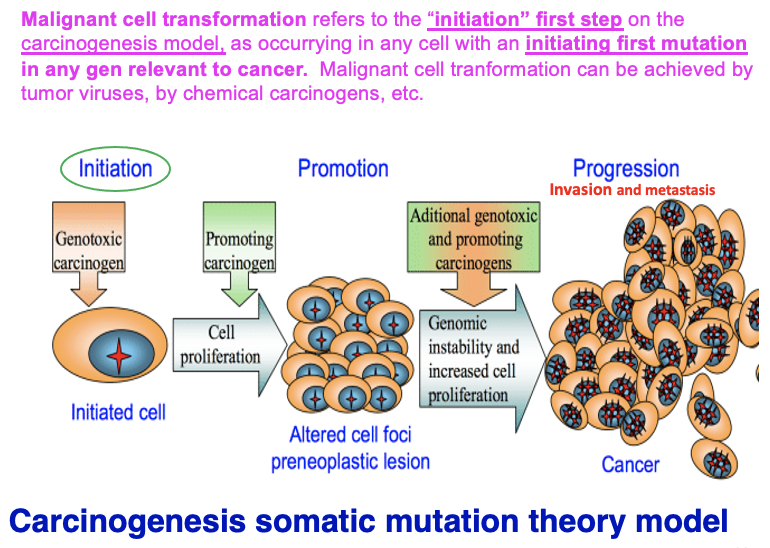
- as occurring in any cell w/ initiating first mutation in any gene relevant to cancer
- malignant cell transformation can be achieved by tumor viruses, chemical carcinogens, etc.
qualities of transformed cells
- immortalization
- aberrant growth control
- loss of contact inhibition
- anchorage independence (colony formation in soft agar)
- tumorigenicity (tumor formation in animals)
- malignancy (formation of an invasive tumor in vivo)
note: transformation is a multistep process, and varying degrees of transformation are measurable
molecular determinants in the conversion from normal to the malignant cellular phenotype: "hallmarks of cancer"
- growth signals
- self-sufficiency in growth signals
- dont need info from growth factors
- insensitivity to anti-growth signals
- cell division
- limitless potential for cellular replication
- escape from apoptosis
- oncogenesis
- tissue invasion and metastasis
cancer cannot be described in vitro, but only in vivo (invasion and metastasis)
Diagnosis in cancer can ONLY be done by a biopsy – shows invasion + metastasis
- invasion when a cell of the benign tumor breaks the yellow membrane and goes into extracellular matrix and into blood
what classifies as cancer?
cancer cannot be described in vitro, but only in vivo
invasion and metastasis
Diagnosis in cancer can ONLY be done by a biopsy – shows invasion + metastasis
- invasion when a cell of the benign tumor breaks the yellow membrane and goes into extracellular matrix and into blood
2 classes of genes in cancer
- oncogenes
- tumor suppressor genes
proto-oncogenes
NORMAL genes in a genome
normal cells that stimulate cell growth and division
Proto-oncogenes are genes that normally help cells grow and divide to make new cells, or to help cells stay alive.
ex: growth factors, mitogens, receptor tyrosine kinases, serine-theronine kinases, GTPases, transc. factors, etc.
oncogene
When a proto-oncogene mutates (changes) or there are too many copies of it, it can become turned on (activated) when it is not supposed to be, at which point it's now called an oncogene.
cause cancer thru gain of function
one of main characteristics of cancer - uncontrolled growth
causes transformation of normal cells into tumor cells
can activate by diff mechanisms (mutagenesis, amplification, mutations, chromosomal translocations, etc.)
ex: Ras, HER2, Myc, Cyclin D
activated proto oncogene
oncogene
gained function
more about proto-oncogenes
- important regulators of biologic processes
- do NOT reside in genome for purpose of promoting tumors
- they are normal biologic process
- play role in cell growth (proliferation, apoptosis, genome stability, differentiation, etc.)
- causes transformation of normal cells into tumor cells
oncogenes associated with retroviruses
(see pic)
ex:
- tyrosine -> abl oncogene -> cause sarcoma in cat
- serine/threonine -> raf oncogene -> cause sarcoma in chicken/mouse
- etc.
cellular oncogenes and their functions
diff functions of growth factors
- all are proto-oncogenic functions required by healthy cell to function
- if any activated -> then have an oncogene
tumor suppressor genes
- provide negative control of cell proliferation in normal genes
- loss of function of proteins encoded by these genes liberated cell from growth constraints -> contributes to malignant control
- are BRAKES in proliferation of cells
- both copies of tumor suppressor gene must be mutated/lost to result in loss of growth control
- they are recessive genes
- ex: Rb, p53, BRCA1/2
mechanisms of tumor suppressor gene inactivation
- deletion
- point mutation
- mutation followed by duplication
- loss of heterozygosity (LOH)
- DNA methylation
- post-transc. mech-bindind to DNA viral oncoproteins
- epigenetic silencing
oncogenes + tumor suppressors
- oncogenes - accelerators
- 1 mutated is enough for excessive cell proliferation
- tumor
suppressor - brakes
- BOTH genes must be inactivated to yield excessive cell proliferation
viruses associated w/ human cancer
HPV
(DNA)
cervical carcinoma
Hep B
(DNA)
liver cancer
herpesvirus: epstein barr virus
(DNA)
burkitt's lymphoma
herpesvirus: HHV8
(DNA)
kaposi's sarcoma
Hep C
(RNA)
liver cancer
retrovirus family
(RNA)
adult T cell leukemia